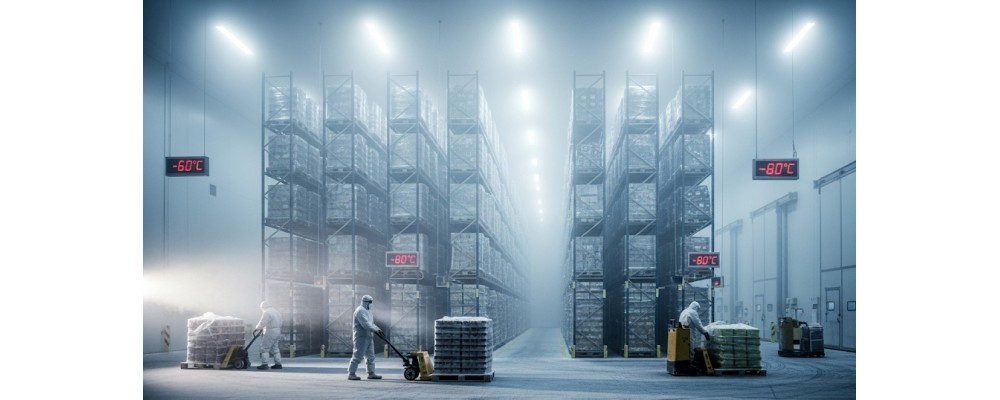A Guide to Ultra-Low Temperature (ULT) Cold Storage: Applications, Design, and Costs
Ultra-Low Temperature (ULT) cold storage refers to specialized facilities designed to operate within a temperature range of -40°C to -120°C. These extreme environments are essential for preserving the integrity of high-value and sensitive products across various sectors, including the medical, scientific research, and high-end seafood industries. By maintaining such low temperatures, ULT storage effectively halts biological and chemical degradation. The construction standards for these facilities are exceptionally strict, with the most common examples being the ultra-low temperature tuna freezers found in coastal regions.
I. Primary Applications of ULT Cold Storage
1. High-Value Food Preservation
ULT freezers are critical for storing expensive seafood that requires long-term preservation, such as Tuna, Swordfish, and Marlin. The ultra-low temperature locks in the product's color, texture, and nutritional value by inhibiting microbial growth and enzymatic decay. This technology is also used for other premium frozen goods like specialty ice creams and quick-frozen foods.
2. Medical and Pharmaceutical Storage
In the medical field, ULT storage is indispensable for the long-term preservation of biological materials. This includes vaccines, blood products, cell samples, tissues, and plasma, all of which require stable, extremely cold conditions to maintain their viability and efficacy.
3. Scientific and Research Applications
Research institutions rely on ULT cold storage to provide reliable, long-term preservation for invaluable scientific materials. This includes biological samples, genetic material (DNA/RNA), and other experimental specimens, ensuring they remain unaltered for future study.
II. Key Features of ULT Cold Storage Construction
1. Advanced Cooling Capacity and Professional Operation
ULT facilities are engineered for powerful and rapid cooling to maintain a stable, deep-freeze environment and prevent product spoilage. Due to the complexity and high technical requirements of the refrigeration system, these facilities are typically smaller in scale and must be operated and maintained by trained professionals.
2. Cascade Refrigeration Systems
To achieve such extreme temperatures, standard refrigeration systems are inadequate. ULT cold rooms utilize cascade refrigeration systems. This advanced technology employs two or more separate refrigeration circuits with different refrigerants. The high-temperature circuit cools the condenser of the low-temperature circuit, allowing the system to efficiently "cascade" down to the target ultra-low temperature.
3. Focus on Energy Efficiency and Sustainability
While ULT systems are energy-intensive, modern designs prioritize energy efficiency and reduced environmental impact. This is achieved through the use of high-efficiency compressors, variable frequency drives (VFDs), and eco-friendly refrigerants, minimizing operational costs and the facility's carbon footprint.
4. High-Performance Polyurethane Insulation
Effective insulation is crucial to minimize energy consumption and maintain temperature stability. ULT facilities are constructed with thick, high-density polyurethane (PU) insulation panels.
Panel Thickness: Common thicknesses range from 150mm to 200mm (6 to 8 inches) to effectively prevent heat ingress.
Properties: These panels provide exceptional thermal insulation, are highly durable, corrosion-resistant, and ensure an airtight seal to prevent cooling loss.
III. Overview of ULT Cold Storage Construction Costs
The cost of building a ULT cold storage facility is significantly higher than that of a standard cold room due to the specialized technology and materials required. Common equipment includes imported German-engineered compressor units, ceiling-mounted unit coolers or aluminum pipe evaporators, and thick polyurethane panels.
General Cost Factors:
The final price is calculated based on a combination of factors, including:
Precise dimensions and volume of the cold room.
Specific temperature requirement (e.g., -60°C vs. -80°C).
Number of rooms or partitions.
Choice of equipment brand and configuration.
Geographic location (influencing labor and logistics costs).
Example Cost Estimates:
While a custom quote is always necessary, here are some general estimates to provide perspective:
A 100 square meter (approx. 1,075 sq ft) ULT facility might cost in the range of $28,000 to $35,000 USD.
For highly specialized applications like a -80°C biological sample repository, the investment can be much higher, potentially reaching $1,400 USD or more per square meter (approx. $130 per sq ft).
To get an accurate budget, it is essential to consult with a specialist contractor who can design a system based on your unique size, temperature, and configuration needs.







Comments: 0
No comments